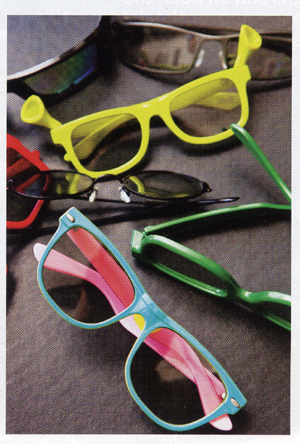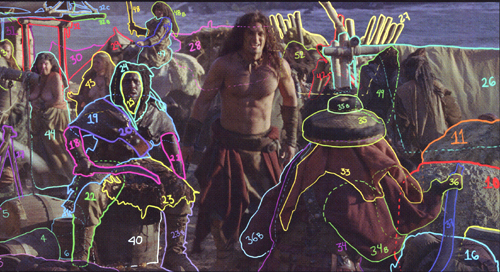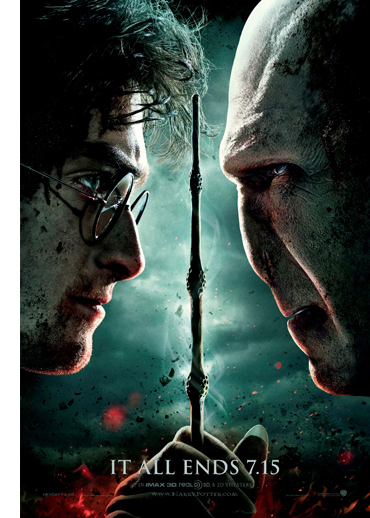Something to do with 2D to 3D conversion for Conan the Barbarian. (See 3DLiveFlix [2])
Kristin here:
Just over a month ago I posted “Do not forget to return your 3D glasses [3],” an entry suggesting that on average theatres were making less money from 3D versions of films than 2D versions. I made two basic points. First, claims that films were making, say, 60% or 45% of their box-office gross from 3D showings were inaccurate. Only the extra fee charged at 3D screenings was for 3D; the rest was for the film as such. By that logic, something closer to around 10% was actually being earned by 3D (assuming people who went to see a film in 3D would probably see it in 2D if necessary.)
Second, my point was that if a film’s box-office percentage from 3D screenings was lower than the percentage of theaters in which it was being shown in 3D, then the exhibitors in those theaters were making less money than exhibitors showing the film in 2D. For most films that have come out this summer, starting in May, the percentage has been distinctly lower.
Wasn’t this supposed to be the summer of 3D?
With the summer movie season drawing to a close, I thought I would summarize some recent developments. These tend to suggest that the decline in the popularity of 3D in the U.S. market has continued. Indeed, a recognition of that decline has started to have an impact on the effort within the industry to pressure theaters into showing films in 3D.
During August I noticed for the first time that trade-paper and online sources are becoming more explicit about saying that 3D is no longer as big a draw as it used to be. Reporting on August 13, the day after the release of Final Destination 5, Variety stated [4], “Though roughly 89% of its screens are in 3D, and 217 are in Imax, ‘Destination’ isn’t expected to see much of a boost from the format given waning interest in 3D. Optimistic B.O. pundits have the film topping out at $21 million through Sunday.”
In fact, Final Destination 5 grossed over $24 million. That was, however, the lowest opening-weekend gross of the franchise. It made about 75% of its gross from 3D screenings, which occupied 80% of locations. That’s better than most 3D films of the summer in proportion of income to screens, but still not great. Its comparatively good performance in 3D suggests that genres like horror still tend to draw the spectators most interested in 3D. Final Destination 5 came in third after two non-3D films, Rise of the Planet of the Apes and The Help, both of which did much better than expected.
The weekend’s other 3D film, Glee the 3D Concert Movie, did so badly that the trades didn’t bother to report its percentages of 3D screens in proportion to income. Its box-office gross put it at #11 on the chart, earning less than $3000 per screen.
The following weekend, August 19-21, saw Rise of the Planet of the Apes and The Help switch slots on the chart, with The Help becoming the first film since January to rise from a #2 opening to the #1 rank—a position it held this past weekend as well, experiencing a low 28% drop despite East Coast theatre closings due to the hurricane.
That same weekend saw three 3D films do lackluster business. Of those, Spy Kids: All the Time in the World did the best, coming in at number 3. About 44% of its income came from 3D, which fits into the 45% level typical of 3D films this summer. Interestingly, though, only 41% of the locations where the film was shown had it in 3D. Variety’s report [5] on Saturday remarked, “The summer’s new norm is to make about 45% of grosses off 3D screens, though that figure could be even lower this weekend with so many pics vying for 3D play and so many of ‘Spy Kids’ engagements opting for 2D.”
There are two implications here. First, if fewer theaters show a film in 3D, the ones that do will make more money, since those moviegoers interested in seeing a film in 3D will converge on that smaller number of theaters. There apparently are not enough such moviegoers to justify having 60% or more of theaters showing 3D. Second, given that four 3D films were debuting that same weekend, theater owners opted to show the film aimed at young children in 2D. We know that there have been complaints that children don’t like wearing the glasses and that parents don’t like shelling out extra fees to take a whole family to a 3D screening. The strategy worked, which again suggests that genres aimed at teenagers might provide the home for 3D, if it survives long-term.
Don’t worry, that includes the whole family. (Just kidding! It’s actually a ticket to last year’s “OnHollywood” trade summit, where 3D was discussed.)
But the teenage-targeting assumption didn’t work out well for the two other 3D debuts of that weekend. Conan the Barbarian showed in 3D in 71% of its locations, but only 61% of its gross came from those locations. The figures were almost identical for Fright Night. Perhaps the two films split the teenage audience, to the detriment of both. Glee fell off 69.4% in its second weekend, to an average of less than $1000 per screen.
The weekend of August 19-21 saw six 3D films in the top 11. (I list 11 rather than 10 because the 11th was the summer’s most successful film and a 3D item, Harry Potter and the Deathly Hallows Part 2.) The 11 were, in order (3D films in bold): The Help; The Rise of the Planet of the Apes; Spy Kids: All the Time in the World; Conan the Barbarian; The Smurfs; Fright Night; Final Destination 5; 30 Minutes or Less; One Day; Crazy, Stupid, Love; and Harry Potter. Of those six films, only two, Harry Potter and The Smurfs, made it to number one—for only one week each, remarkably.
Still doing well abroad
The big Hollywood studios continue to defend 3D as a financial strategy, since films made with the process continue to clean up in most foreign territories. Even though the percentage of 3D box-office income has fallen to a fairly consistent 45% (apart from the occasional genre film), it still provides about 60-70% of the international gross. (Unfortunately percentages of theaters showing 3D films aren’t given in such reports.)
Variety’s Andrew Stewart helps explain [8] how some foreign markets encourage 3D viewing:
To some degree, the divergence can be chalked up to a matter of preference — some cultures just like 3D more than others for reasons that can’t be quantified, and big-budget f/x spectacles continue to draw big auds overseas — but there are also some subtle differences in local pricing models that provide insight to studios and exhibitors eager to see 3D pay off on its promise of enhanced B.O. takings.
Some notable factors: Many international markets temper 3D upcharges with discount play periods. China has half-price Tuesdays. In Germany, “Cinema Day” brings a steep midweek price drop to matinees. And some territories even charge less for 3D pics that have shorter running times. In many countries, premium ticket prices for 3D are further mitigated because moviegoers are encouraged to buy their own reusable glasses.
[…]
Some Japanese exhibs ease 3D ticket prices by charging less to those who bring their own glasses. Dolby controls most of the Japanese 3D market, and in March, the company started offering reusable 3D glasses for $12 per pair. In Europe, RealD sells its reusable glasses at concession stands or the ticket window for about E1, saving auds the repeated expense.
But if theaters attract customers by giving discounts or waiving fees for those who bring their own glasses, how long can the high proportionate income from 3D hold up? Sales of glasses benefit the technology companies, not the theater or studios, and eventually the market will be largely saturated.
So far 3D is holding up well in most foreign markets, but there is one exception. In Spain, where the 3D premium averages a whopping 37%, Transformers earned 49% of its national gross from 3D, Pirates of the Caribbean 41%, and The Smurfs 39%. Variety blames the sag on 22% unemployment and “rampant piracy.” But unemployment and piracy aren’t unique to Spain by any means.
And foreign markets got into 3D exhibition a bit later than North America did. There’s nothing to say that ticket premiums and the decline in the novelty value of 3D won’t start affecting international exhibition eventually.
A certain lack of confidence
The August 12 edition of The Hollywood Reporter revealed that RealD’s “stock has plunged 60 percent since reaching a 52-week high in June as U.S. audiences seem to tire of the format.” Now that’s serious. Two weeks later, in the August 26 edition, a smiling Michael Lewis, the firm’s CEO (below), was given a two-page spread with an interview where he explained why he thought Wall Street was overreacting. (These references are to the print edition; online they’re behind a pay wall.)
Clearly, it was an overreaction. We had record earnings. We’re a relatively new company, and as time goes on we’ll prove the model. It doesn’t really matter if a film does 40 percent or 50 percent; we just believe this is a transformative event like the Internet and the personal computer. All visual displays are going to get better, and we’re really well positioned. Over time, Wall Street will figure that out.
That’s a remarkable claim. Many of us might say, “I don’t know how I got along before computers” or “before the Internet.” How many people would really say “I can’t imagine what we did before 3D came along”? This is hardly a transformative event on a scale even vaguely close to those two technologies. I can easily get along without seeing a film in 3D, but I would never go back to an era when endnotes didn’t rearrange themselves automatically  [9]when you moved or added a reference in your text. Think, too, how profoundly computers and Internet have affected the world financially, and then compare that with the impact of 3D.
[9]when you moved or added a reference in your text. Think, too, how profoundly computers and Internet have affected the world financially, and then compare that with the impact of 3D.
Lewis also seems disingenuous when he claims that whether a film does 40% or 50% of its business in 3D “doesn’t really matter.” It certainly matters to the local multiplex owner who sees more people going into an auditorium showing a movie in 2D than another auditorium showing it in 3D. It matters to the distributor who gets a cut of the take and to the studio that gets the remainder–and had to pay extra to begin with to make the film in 3D.
He may be right, though, that Wall Street overreacted. The interview includes some impressive figures. RealD controls roughly 85% market share of the domestic 3D box office. (Apart from selling its projection systems, special screens, and glasses to theaters, RealD gets a licensing fee averaging fifty cents for every ticket sold.) Within the U.S., it has 10,300 screens in 2,500 locations; abroad, the number is 7,200 screens in 2,300 locations. The firm’s 2011 fiscal-year revenue was $246.1 million, up 64% from the previous year. Its fiscal-year 2011 gross profit was $67.7 million, up 633%. This is flashy–though such growth came during the post-Avatar era when theaters which had missed out on the film’s bonanza were buying 3D equipment at a good clip, and more 3D films were in the pipeline. (Lewis says 2011 will see forty 3D films released.) If theater conversion is nearing saturation point and 2D screenings are outdrawing 3D ones, though, this summer may mark the end of the expansion for companies like RealD.
Lewis doesn’t exactly win me over either with his notions of what to do with 3D. He’d like to convert Singin’ in the Rain into 3D. That and The Love Bug. You know, the great classics. Plus he has a rather peculiar idea of Avatar‘s place in film history. Asked what Cameron’s film did for the business of 3D, Lewis responded: “It legitimized it. It was the Citizen Kane of our medium. After Avatar, I finally didn’t have to go into a meeting and explain why this was going to be important for our industry. The numbers spoke for themselves.” No doubt Avatar‘s phenomenal box-office success made exhibitors who had not yet installed 3D equipment keen to do so. But Kane was in fact not a financially successful film. No one could say of it, “After Kane, I didn’t have to go into a meeting and explain why deep focus was going to be important for our industry. The numbers spoke for themselves.” Both films are undoubtedly historically important, but there’s really very little comparable about them.
Auteurs to the rescue?
Speaking of legitimacy, Lewis is looking forward to the releases of Martin Scorsese’s Hugo in November and Ridley Scott’s Prometheus next year. On August 12, the Wall Street Journal ran a long story [10]by Michelle Kung on how a trio of Movie Brats are about to reveal their first 3D films. Hugo is scheduled for November 23, Steven Spielberg’s The Adventures of Tintin for December 23, and Francis Ford Coppola’s Twixt premieres in September at the Toronto Film Festival.
Spielberg’s popularity among a broad range of audiences remains intact, though whether Belgian import Tintin can win American spectators’ hearts remains to be seen. Whether Scorsese and Coppola, beloved of audiences of my generation, will prove the final boost that 3D needs is up for grabs. Coppola seems a particularly unlikely auteur to pin one’s hopes on. Twixt, a low-budget horror film, has only five minutes of 3D footage, and it has yet to find an American distributor. According to Anne Thompson’s blog [11], the director “first showed the film to distributors in Los Angeles Wednesday night [i.e., August 24]. Unless he gets a rich offer, Coppola will likely four-wall the film himself; he’s looking to sell video rights.” Today’s Variety reports [12] that Pathé has picked up Twixt for “international sales and distribution in France.” That doesn’t seem to settle the question of a U.S. release.
A more likely shot in the arm for 3D would seem to be Peter Jackson’s Hobbit film, being shot even as I type. It should appeal to teenage 3D buffs and just about everyone else. But the first part is not due out until December, 2012. I suspect that the degree to which 3D will penetrate the theatrical market will be known by then.
The article quotes Jeffrey Katzenberg, who years ago claimed that every screen would eventually be converted to 3D, as saying “You now have some of the greatest filmmakers in the world stepping into the format to tell their stories.” Scorsese has gamely stepped up to the plate, commenting that if 3D had been around when he made Mean Streets or Taxi Driver or Raging Bull, “those stories would have fit in perfectly in 3-D.” It’s a bizarre thought, but maybe he’s serious.
Kung provides some interesting figures. It’s difficult to get a sense of how many people are opting to see 3D films in their 2D versions. Usually the comparison is made in terms of box-office gross rather than number of tickets. But the author says that 57% of people who saw the final Harry Potter film this summer opted for 2D, which seems a pretty significant figure. She also notes the falling stocks of RealD and other 3D firms:
“Consumers are pushing back,” says Richard Greenfield, an analyst at brokerage firm BTIG. “They’re tired of 3-D, both from a price perspective and from a physical-comfort perspective.” He adds that consumers have come to a key realization: A bad film in 3-D is still a bad film.”
Kung says that about 30 new 3D films are due for release next year. If Lewis’ figure of 40 for 2011 is accurate, that means a notable drop in planned 3D productions for the short term. Possibly it’s a temporary one, but perhaps studios are beginning to think that the extra returns from their share of those ticket premiums aren’t worth the cost and effort. If 57% of Harry Potter‘s audience opted for 2D, then perhaps an increasing number of theater owners are refusing to book 3D films from the distributors.
That figure of 30 releases doesn’t include the announced 3D conversions of Titanic and the Star Wars series, which may or may not be ready for release next year. The rumors of such conversions for these and other popular items like the Lord of the Rings film have been circulating, but precious little information on how, when, and where these will eventually reach theaters has been forthcoming.
As I’ve said in my previous posts on 3D, I don’t see any reason why the format would necessarily disappear. Once the match of number of 3D screens and number of moviegoers who want to see 3D movies reaches a reasonable balance–which at this point seems to mean a significant number of current 3D screens reverting to 2D–both formats will make money and 3D will continue, especially for blockbusters and teenage-oriented genre films. But the idea that studio and company executives can simply dictate that the entire public should embrace what is, after all, a relatively superficial technology added onto an already stable and successful product seems overweening and implausible. This summer’s movies have seemingly reflected the public’s more realistic attitude.
And now, enough of 3D. Unless something dramatic happens between now and when Hugo comes out, I shall hold off writing on the subject until we see what happens during the holiday season, when the format faces its next big test.
P.S. August 31: The Fandor blog has a post by Alejandro Adams [13], a filmmaker who manages a multiplex in northern California. He reports that until recently, studios demanded that all 3D films be shown only in 3D, no matter how many screens were available. Adams reports that this summer: “We’d just opened Captain America ‘over/under,’ meaning that we were offering two 2D shows and three 3D shows in a single auditorium. This was the first time any studio had allowed us to restrict the number of 3D shows. When I checked the grosses after opening day, I was alarmed. We sold twice as many tickets for 2D as 3D. As we’d never booked a 2D engagement of any film available in 3D, I’d never seen this disparity up close. The fact that we were permitted to over/under Captain America in 3D and 2D is itself a distressing development—are the studios suddenly willing to admit they didn’t hit the jackpot with the 3D craze? Are they going to start phasing out 3D so soon after we went to the trouble and expense of making our projectors and screens compliant with their demands?”
Adams calls this a “distressing development,” being a fan of 3D, both for his own and his children’s enjoyment. If my hunch turns out to be correct, they will still have the 3D option, but others will have access to 2D screenings.
RealD’s Michael Lewis. Hmm, those glasses do look a bit clunky. (Photo by Peden + Munk)


